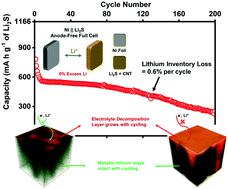当前位置:
X-MOL 学术
›
Energy Environ. Sci.
›
论文详情
Our official English website, www.x-mol.net, welcomes your
feedback! (Note: you will need to create a separate account there.)
Lithium degradation in lithium–sulfur batteries: insights into inventory depletion and interphasial evolution with cycling
Energy & Environmental Science ( IF 32.4 ) Pub Date : 2020-07-03 , DOI: 10.1039/d0ee01074j Sanjay Nanda 1, 2, 3, 4 , Arumugam Manthiram 1, 2, 3, 4
Energy & Environmental Science ( IF 32.4 ) Pub Date : 2020-07-03 , DOI: 10.1039/d0ee01074j Sanjay Nanda 1, 2, 3, 4 , Arumugam Manthiram 1, 2, 3, 4
Affiliation

|
The promise of high energy density lithium–sulfur batteries with long cycle life is currently tempered by the rapid degradation of lithium-metal anodes with cycling. An in-depth understanding of the dynamical behavior in liquid electrolytes, including the mechanisms underlying depletion of lithium inventory and evolution of lithium interphases, is crucial to make Li–S batteries a reality. We use here an anode-free full cell configuration, pairing a Li2S cathode with a bare nickel current collector with no lithium metal on it, to quantitatively estimate the lithium inventory loss per cycle. Lithium inventory loss is shown to be the main factor limiting the overall cyclability of Li–S batteries. Time-of-flight secondary ion mass spectrometry measurements on the deposited lithium reveal the presence of substantial metallic lithium even after most of the active lithium inventory has been depleted. The trapped metallic lithium is rendered electrochemically inactive by the growth of a resistive electrolyte decomposition interphase on the lithium surface. The bulk of the deposited lithium is shown to be composed of various fully reduced interphasial components, including several hydrogen-containing species that show a substantial reduction in intensity with cycling. This indicates considerable gas evolution and is also correlated with the loss of lithium inventory. The use of an anode-free full cell configuration provides a framework for accurate assessment of the dynamics of lithium inventory depletion and characterization of the accompanying interphasial evolution with cycling. The insights gained will prove invaluable to the development of strategies for extending the cycle life of energy-dense Li–S batteries.
中文翻译:

锂硫电池中的锂降解:对库存消耗和循环间演化的见解
高能量密度锂-硫电池具有长循环寿命的前景目前因锂金属阳极随着循环的迅速降解而受到削弱。深入了解液体电解质的动力学行为,包括锂储量枯竭和锂中间相演变的潜在机制,对于使Li-S电池成为现实至关重要。我们在这里使用无阳极的完整电池配置,将Li 2配对S阴极上有裸露的镍集电器,上面没有锂金属,以定量估算每个周期的锂库存损失。锂库存损失被证明是限制Li-S电池整体可循环性的主要因素。即使在大部分活性锂存量耗尽之后,对沉积的锂的飞行时间二次离子质谱分析也显示出存在大量金属锂。通过在锂表面上电阻电解质分解界面的生长,使捕获的金属锂在电化学上失活。示出的大部分沉积的锂由各种完全还原的相间组分组成,包括几种随着循环强度显着降低的含氢物质。这表明大量的气体逸出,并且还与锂存量的损失有关。无阳极全电池配置的使用提供了一个框架,可用于准确评估锂库存耗尽的动力学以及表征伴随循环的相间演化。所获得的见识将对延长能源密集型Li-S电池循环寿命的策略的开发具有不可估量的价值。
更新日期:2020-08-14
中文翻译:

锂硫电池中的锂降解:对库存消耗和循环间演化的见解
高能量密度锂-硫电池具有长循环寿命的前景目前因锂金属阳极随着循环的迅速降解而受到削弱。深入了解液体电解质的动力学行为,包括锂储量枯竭和锂中间相演变的潜在机制,对于使Li-S电池成为现实至关重要。我们在这里使用无阳极的完整电池配置,将Li 2配对S阴极上有裸露的镍集电器,上面没有锂金属,以定量估算每个周期的锂库存损失。锂库存损失被证明是限制Li-S电池整体可循环性的主要因素。即使在大部分活性锂存量耗尽之后,对沉积的锂的飞行时间二次离子质谱分析也显示出存在大量金属锂。通过在锂表面上电阻电解质分解界面的生长,使捕获的金属锂在电化学上失活。示出的大部分沉积的锂由各种完全还原的相间组分组成,包括几种随着循环强度显着降低的含氢物质。这表明大量的气体逸出,并且还与锂存量的损失有关。无阳极全电池配置的使用提供了一个框架,可用于准确评估锂库存耗尽的动力学以及表征伴随循环的相间演化。所获得的见识将对延长能源密集型Li-S电池循环寿命的策略的开发具有不可估量的价值。











































 京公网安备 11010802027423号
京公网安备 11010802027423号